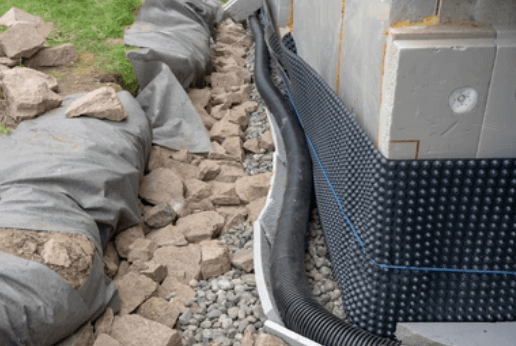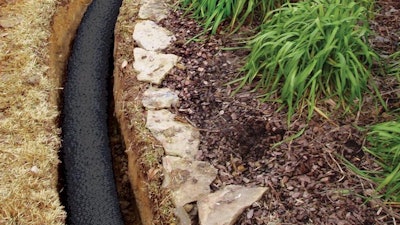The Essential Guide to Maintaining Your French Drain for Long-Lasting Efficiency
Maintaining your French drainpipe is key to its efficiency and your home's protection. Routine checks can save you from pricey fixings and water damage. You'll need to know what signs to seek and how often to evaluate your system. And also, recognizing the cleansing procedure can make a substantial distinction. Allow's discover the crucial actions for guaranteeing your drain functions well for several years to come.
Understanding the Function of a French Drainpipe
A French drainpipe is a crucial part in managing water around your home. It routes excess water away from your foundation, avoiding flooding and damage. When heavy rainfall falls, the drainpipe accumulates water with a perforated pipeline buried in gravel. This system allows water to stream openly, lowering stress on your basement wall surfaces and lessening the risk of leaks.You could ask yourself exactly how it functions in technique. As water fills the dirt, gravity draws it towards the drainpipe. The perforated pipeline records this water, moving it to a designated drainage location or storm drain. This process maintains your backyard completely dry and protects your home's structural integrity.Understanding exactly how a French drain functions is essential to appreciating its importance. By properly directing water away, it assists keep a completely dry and risk-free living atmosphere. Keeping your French drain in leading condition warranties you prevent expensive repair work down the line.
Routine Evaluations: What to Search for
When you're inspecting your French drainpipe, begin by inspecting for any type of blockages that could be obstructing water circulation. Take notice of indications of surface area disintegration around the drain, as this can show possible problems. Regular evaluations will certainly assist keep your drainage system functioning properly.
Clogged Drain Analysis
How can you inform if your French drain is clogged? First, expect water merging in your yard, especially after heavy rainfall. That's a red flag if you observe locations where water gathers rather of draining. You need to additionally inspect the drainpipe outlet; if water isn't spurting as it should, there's likely a clog. Listen for unusual gurgling sounds, which can show trapped air. Additionally, examine the drain's surface area for any vegetation development, as roots can penetrate and obstruct the system. If you scent mildewy odors, it can point to stagnant water caused by a clog. On a regular basis reviewing these indicators can help you maintain your French drainpipe efficiently and avoid costly repairs.
Surface Area Disintegration Check

Cleaning Your French Drainpipe: Step-by-Step Overview
Cleansing your French drain is essential for maintaining it operating correctly. You'll need some certain tools and a clear process to assure whatever runs smoothly. Allow's go through the steps and pointers for keeping your drain successfully.
Devices You'll Need
To deal with the task of cleansing your French drain efficiently, you'll wish to collect a couple of necessary devices. First, grab a tough pair of handwear covers to protect your hands from debris and sharp things. A small shovel or trowel will certainly aid you eliminate dust or blockages around the drain. For cleaning out the interior, a plumbing professional's serpent or a high-pressure water nozzle can be exceptionally helpful. You'll likewise require a container for accumulating any kind of debris you take out. Having a garden hose on hand will make it simpler to wash out the drain and guarantee it's flowing smoothly. With these devices prepared, you'll be set for a thorough cleansing session!
Cleaning Up Refine Steps
Beginning by examining the location around your French drainpipe for any kind of noticeable particles or blockages. Eliminate fallen leaves, branches, or dust that may block water flow. Next, examine the inlet and outlet locations; clear any type of blockages to guarantee correct drainage. Use a yard pipe to flush the drain, directing water right into the inlet. This helps dislodge any type of gathered sludge or debris. Consider using a plumbing professional's serpent to damage them up if you observe persistent obstructions. After cleaning, examine the gravel around the drainpipe; replenish it if it's gotten rid of. Validate the drainpipe covers are undamaged and securely in area to protect against particles from going into. Routine cleaning maintains your French drain operating successfully.
Upkeep Regularity Tips
While regular maintenance is vital for your French drainpipe's durability, recognizing how usually to maintain it can make all the difference. Ideally, you ought to evaluate your French drain a minimum of twice a year, ideally in spring and fall. After heavy rains or snowmelt, look for clogs or debris. If you notice any standing water, it's time to cleanse your drain.In areas with heavy vegetation, even more constant maintenance-- regarding every 3 months-- may be needed. Furthermore, take into consideration cleansing your French drainpipe after significant storms or if you observe water pooling in your backyard. By remaining proactive, you'll guarantee your French drainpipe functions efficiently and secures your home from water damage. Normal checks will conserve you money and time in the long run.
Recognizing Common Issues and Their Solutions
When you discover water pooling in your yard or damp spots in your basement, it's vital to recognize typical problems with your French drainpipe and execute reliable remedies. One constant issue is blocking, commonly created by particles like fallen leaves or debris. To repair this, you can use a pipes snake or a high-pressure water jet to clear blockages.Another issue could be incorrect slope. Water will not stream away from your home if your drainpipe isn't sloped correctly. You can adjust the go to this web-site slope by digging and rearranging the drainpipe pipe.Lastly, check for damages or fractures in the drainpipe itself. Changing the damaged areas is important for peak performance if you find any. By attending to these problems immediately, you'll help ensure that your French drain continues to operate properly, securing your residential or commercial property from water damage and maintaining a completely dry, secure environment.
Seasonal Maintenance Tips for Your French Drainpipe
Attending to common problems with your French drain is simply the very first step in assuring its long-lasting performance. Seasonal maintenance is crucial for peak performance. In the spring, clear away leaves and debris that may have collected during winter season. Inspect for any kind of clogs in the outlet or catch basin, as water needs a clear path to flow freely.During summer, check your drainpipe for any kind of indications of settling or shifting soil. Make sure it's still level and operating effectively. As loss strategies, clear out any type of dropped entrusts to stop obstructions prior to winter season arrives.In winter months, watch for freezing temperature levels. Make certain your drain isn't at threat of cold if you live in a cool environment. Protecting subjected pipes can assist. Regular checks and timely maintenance can stop pricey repair work and keep your French drain functioning successfully year-round. Remain proactive and enjoy satisfaction recognizing your drainage system remains in excellent shape!
When to Hire a Specialist
Knowing when to call in a professional can save you time and protect against more damages to your French drainpipe. If you see consistent standing water in your yard, it's a clear sign that your drain may be blocked or harmed. Do not ignore weird odors, as they can indicate sewer back-up or degeneration, which requires immediate attention.If you locate that your drainpipe isn't working appropriately after efforts to clean or maintain it, it's time to get to out for professional assistance. Furthermore, if you're unsure about the underlying problems or do not have the necessary tools, employing a specialist can offer tranquility of mind.Finally, if your French drain is old or has actually experienced considerable deterioration, expert evaluation can establish whether repair services or full replacement is needed. Count on the professionals to assure your drain system functions effectively for years to come.
Tips for Protecting Against Future Drainage Problems
To maintain your French drain functioning efficiently, on a regular basis evaluating and preserving it can make all the difference. Beginning by removing debris, leaves, and dirt from the surface area and drainpipe openings. This protects against clogs that can result in water back-up. Inspect the crushed rock around the drainpipe; if it's compressed or deteriorated, think about adding fresh crushed rock to preserve excellent flow.Next, divert water far from your drainpipe by guaranteeing downspouts and gutters are clear and routing water at the very least three feet away from your structure. Frequently evaluate for any kind of indicators of damage or sagging. If you observe issues, resolve them immediately.Finally, think about setting up a catch or a filter basin to catch bigger particles before it enters the drain. By staying proactive with these suggestions, you'll minimize the risk of future drainage issues and maintain your French drainpipe in top form.
Regularly Asked Concerns
How much time Does a French Drainpipe Commonly Last?
A French drain commonly lasts around 30 to 40 years, relying on the materials utilized and maintenance (Portland French Drain). If you stay on top of routine checks, you can extend its life-span also additionally
Can I Set Up a French Drainpipe Myself?
Yes, you can set up a French drainpipe yourself if you have actually obtained the right devices and knowledge. Simply make particular to prepare carefully, follow local regulations, and guarantee appropriate drain to stay clear of future concerns.
What Materials Are Used in a French Drainpipe?
You'll need perforated pipe, crushed rock, landscape textile, and a solid drainage pipeline for your French drain. These materials aid redirect water successfully, preventing flooding and maintaining your home risk-free and dry from water damages.

Is a Permit Required to Mount a French Drain?
You'll likely require an authorization to install a French drainpipe, depending upon local policies. Consult your community to assure you comply with any required guidelines and prevent potential problems throughout setup.
What Are the Prices Related To French Drainpipe Maintenance?
Maintaining look at here a French drain typically sets you back between $100 and $500 each year. You'll require to think about costs for cleaning, fixings, and assessments. Normal maintenance helps useful site protect against bigger expenses and assurances your system operates correctly for several years - Portland French Drain. When you're examining your French drainpipe, start by inspecting for any obstructions that may be obstructing water flow. By staying aggressive, you'll guarantee your French drain functions efficiently and secures your home from water damage. When you see water merging in your yard or damp places in your cellar, it's vital to recognize typical issues with your French drainpipe and carry out effective options. You can change the slope by digging and rearranging the drainpipe pipe.Lastly, check for damages or cracks in the drainpipe itself. Examine the gravel around the drain; if it's compressed or worn down, consider including fresh crushed rock to maintain excellent flow.Next, divert water away from your drainpipe by guaranteeing downspouts and gutters are clear and routing water at least 3 feet away from your structure